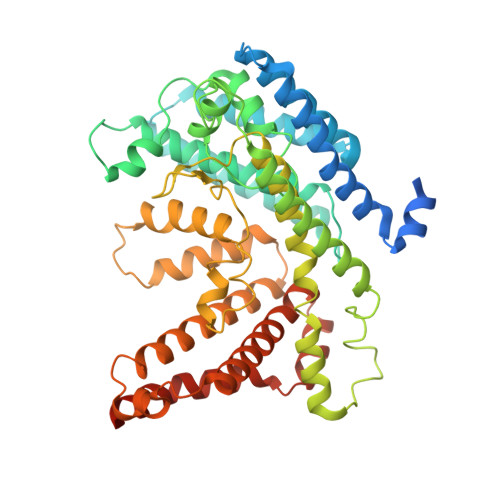The structural basis for the phospholipid remodeling by lysophosphatidylcholine acyltransferase 3.
Zhang, Q., Yao, D., Rao, B., Jian, L., Chen, Y., Hu, K., Xia, Y., Li, S., Shen, Y., Qin, A., Zhao, J., Zhou, L., Lei, M., Jiang, X.C., Cao, Y.(2021) Nat Commun 12: 6869-6869
- PubMed: 34824256
- DOI: https://doi.org/10.1038/s41467-021-27244-1
- Primary Citation of Related Structures:
7EWT, 7F3X, 7F40 - PubMed Abstract:
As the major component of cell membranes, phosphatidylcholine (PC) is synthesized de novo in the Kennedy pathway and then undergoes extensive deacylation-reacylation remodeling via Lands' cycle. The re-acylation is catalyzed by lysophosphatidylcholine acyltransferase (LPCAT) and among the four LPCAT members in human, the LPCAT3 preferentially introduces polyunsaturated acyl onto the sn-2 position of lysophosphatidylcholine, thereby modulating the membrane fluidity and membrane protein functions therein. Combining the x-ray crystallography and the cryo-electron microscopy, we determined the structures of LPCAT3 in apo-, acyl donor-bound, and acyl receptor-bound states. A reaction chamber was revealed in the LPCAT3 structure where the lysophosphatidylcholine and arachidonoyl-CoA were positioned in two tunnels connected near to the catalytic center. A side pocket was found expanding the tunnel for the arachidonoyl CoA and holding the main body of arachidonoyl. The structural and functional analysis provides the basis for the re-acylation of lysophosphatidylcholine and the substrate preference during the reactions.
- CAS Center for Excellence in Molecular Cell Science, Shanghai Institute of Biochemistry and Cell Biology, Chinese Academy of Sciences, University of Chinese Academy of Sciences, 333 Haike Road, Shanghai, 201210, China.
Organizational Affiliation:

















